|
Aplysina gerardogreeni AND Aplysina
aztecus (PORIFERA: DEMOSPONGIAE), NEW SPECIES FROM THE MEXICAN
PACIFIC
Trabajo recibido el 7 de julio de 1992 y aceptado para su
publicación el 30 de septiembre de 1992.
Aplysina gerardogreeni y Aplysina aztecus (PORIFERA: DEMOSPONGIAE), NUEVAS ESPECIES DEL PACÍFICO MEXICANO
Patricia Gómez
Instituto de Ciencias del
Mar y Limnología, Universidad Nacional Autónoma de México.
Apartado Postal 70-305, México, D.F. 04510, MÉXICO.
Gerald J. Bakus
Allan Hancock Foundation, University of Southern
Califomia, Los Angeles, CA, 90089-0371, USA. Contribución No 725 del
Instituto de Ciencias del Mar y Limnología.
Se describen dos especies nuevas del
Orden Verongida, Porifera: Aplysina gerardogreeni y
Aplysina aztecus, colectadas mediante arrastre, durante un
crucero oceanográfico y por buceo SCUBA en diferentes localidades del
Pacífico mexicano. Aplysina gerardogreeni es de
constitución masiva, provista de tubos pequeños en la cima,
amarillo-ocre, fibras de espongina no distinguibles entre primarias y
secundarias, 30-150 µm de diámetro, médula 33-80% del
diámetro de la fibra, mallas 200-2000 µm de abertura y
cámaras coanocíticas de 12-17 µm Aplysina
aztecus presenta forma de globo sostenido por un pedúnculo,
amarillo brillante, fibras de espongina no distinguibles entre primarias y
secundarias, 50-200 µm de diámetro, médula 30-95% del
diámetro de la fibra, mallas 285-2000 µm de abertura y
cámaras coanocíticas de 23 µm.
Two sponges of
the Order Verongida are described: Aplysina gerardogreeni
and Aplysina aztecus, collected by dredging durring an
oceanographic cruise and by SCUBA diving at different sites on the Pacific
coast of México. Aplysina gerardogreeni is massive,
with small tubes on top, ochre-yellow, spongin fibers not distinguishable
between primaries and secondaries, 30-1.50 µm in diameter, pith 33-80%
of the fiber diameter, meshes 200-2000 µm wide and choanocyte chambers
12-17 µm Aplysina aztecus is globose-like and supported by a stalk,
bright yellow, spongin fibers not distinguishable between primaries and
secondaries, 50-200 µm in diameter, pith 30-95 % of the fiber diameter,
meshes 285-2000 µm wide, and choanocyte chambers 23 µm.
Sponges of the Order Verongida have been of considerable interest to biochemists because they contain a wide variety of brominated compounds, (e.g., Tymiak et al., 1985). Aplysina (Verongida) is a rich source of marine antibacterial compounds, such as aeroplysinin-1 (Rinehart et al., 1981). Bromophenols have been suggested to be useful in the chemotaxonomy of the genus Aplysina. Aplysina fistularis (Verongia aurea, Verongia thiona) has been shown to exhibit antifouling activities (Thomson, 1985). Several new brominated metabolites were recently characterized by Cruz et al., (1990) from Aplysina thionacollected at Puerto Escondido Bay in Oaxaca, México. Until recently, only A. fistularis was Known from southern California and México. Two new species of Aplysina were recently discovered from. the Mexican Pacific. The purpose of this paper is to describe these two new species so that chemists will be able to adequately compare the biochemistry of brominated metabolites in several members of the genus Aplysina from the Mexican Pacific. Many poriferans remain undescribed in the world at normal SCUBA diving depths (0-43 m). This is especially true of the Mexican Pacific Records of sponges from this area are incomplete and include species from Acapulco (Carter, 1882), the Gulf of California (Dickinson, 1945; Hofknecht, 1978), and Mazatlán (Green & Gómez, 1986). Moreover, sponges have been collected along the Pacific coast of México for pharmacological, studies. Sponges in this study were taken from the Gulf of California to Oaxaca (Fig. 1). They were collected by dredging at depths of 20 to 100 m from the R/V El Puma. Other collections were made. by SCUBA near rocky shores at depths of 0 to 25 m. From these collections, 13 species were described from Mazatlán (Green & Gomez, 1986). Holotypes, are deposited in the invertebrate collection of Marine Pharmacology Laboratory, Instituto de Ciencias del Mar y Limnología, UNAM. 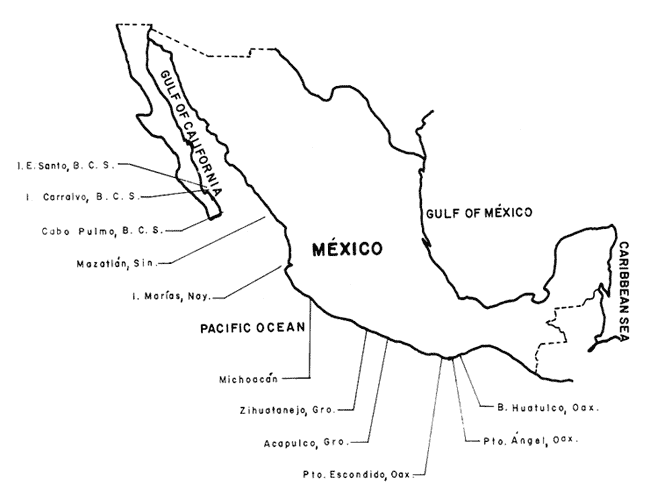 Figura 1. Map of México with collecting sites. SYSTEMATICSOrder Verongida Bergquist, 1978 Family Aplysinidae Carter, 1875. Genus Aplysina Nardo, 1833 Aplysina gerardogreeni n. sp. (Plates 1 and 2) Localities: Cerralvo and Espíritu Santo Islands, B.C. S.; Mazatlán Sinaloa; Islas Marías Nayarit; Acapulco and Zihuatanejo, Guerrero; B. Huatulco, Puerto Ángel and Puerto Escondido, Oaxaca, México. Depth 6-33 m, on rock The shape is massive and lobular. The sponge measures 10- 18 cm wide and 3-6 cm high; the lobules measure 3-25 mm high and 5- 10 mm in diameter. Each lobule has an oscule at the top; the oscules measure 450-3000 µm in diameter. The color in life is ochre-yellow at the base, and reddish on the top; in alcohol the sponge turns dark purple. 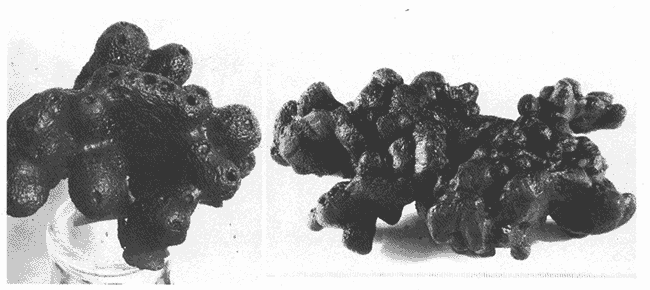 Plate I. A. gerardogreeni n. sp. The consistency in life and in alcohol is firmly spongy. It is hard when dry. The surface is finely conulose, the, conules measuring; < 1 mm high. The dermis nicasures 60-278 µm thick. It is distinguishable from the choanosome by its condensed pigmentation. Pores are not apparent.  PlateI II. A. gerardogreeni n. sp., detail of the skeleton The choanosome is difficult to macerate. The atrium measures 1-2 mm in diameter. The choanocyte chambers measure 12-17 µm in diameter. An irregular polygonal fibroreticulation is present. The, spongin fibers are ambercolored, stratified and pithed, without distinction between primaries and secondaries. Their diameters measure 30-150 µm the, thicker diameters often located at the, center and base of the sponge. The pith occupies 33-80% of the fiber diameter. The meshes measure 200-2000 µm (x - 495µm). 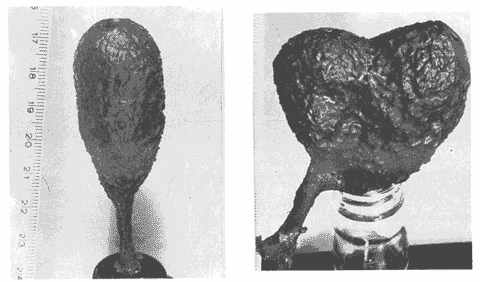 Plate III. A. aztecus n. sp. 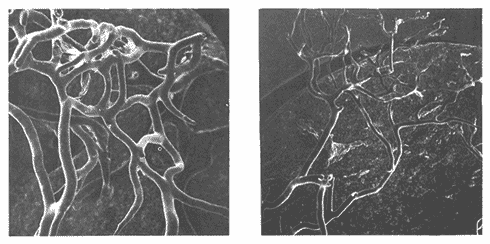 Plate IV. A. aztecus n. sp., detail of the skeleton. Remarks: Aplysina gerardogreeni is superficially similar to A. fistularis, but is more massive and lobular. Moreover, the pith diameters of the spongin libers show virtually no overlap in size in the two species (Table 1). Aplysina gerardogreeni appears to be abundant along the Pacific coast of México on rocky substrata to 33 meters depth. This species produces brominated metabolites with antimicrobial activity (Cruz et al., 1990). The new species name is dedicated to the late Dr. Gerardo Green, researcher on Mexican sponges, and a friend and fellow scientist.  TABLE 1. Aplysina gerardogreeni n. sp.compared with the closest species Aplysina aztecus n. sp (Plates 3 and 4) Localites: Espíritu Santo IS., Baja Califonia Sur, Nayarit and Michoacán México; depth 14-70 m, on sand. Acapulco and Zihuatanejo, Guerrero, México; depth 14-43 m on rock. The shape is typically a stalked globe, sometimes two or three globes joined, together; no transitional shapes during development were found. The total height is up to 13 cm, the globe often 3-4 cm in greatest diameter, and the stalk 3 cm long and 5-6 mm in diameter. The color in life is bright yellow on rock and pink with yellow tinges on sand. In alcohol the color turns dark purple. The consistency of the globe is firmly spongy and the stalk is hard; all parts are hard when dry. 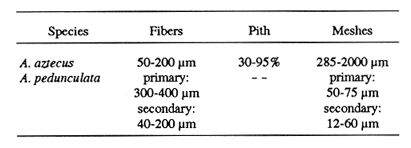 TABLE 2. Aplysina aztecus n. sp. compared with the closest species The surface is very finely conulose in some areas and smooth in others. Oscules are often located on the top of the globes, with some at the lateral edge. They measure 2-10 mm in greatest diameter, the largest oscules located at the top of the globe. The dermis is easy to detach and is differenciated from the choanosome by condensad pigment cells; the thickness of the dermis is 85-600 µm Pores measure 28-93 µm (x = 36 µm) in diameter and are surrounded by a fibroreticulation of hexagonal meshes. The choanosome, is cheese-like; it is traversed by an atrium with an average diameter of 4 mm, opening at the oscule. Aquiferous canals mesure 37-500 µm in diameter. Cylindrical choanocyte chambers measure 23 µm in diameter The skeleton consists of polygonal, elongated meshes; in peripheral regions becoming dendritic. Spongin fibers are amber-colored, stratified and pithed. There is no distinction between primary and secondary fibers. Meshes measure 285-2000 µm wide, the smallest ones located at the periphery of the sponge. Spongin fibers measure 5O-200 µm thick. The pith usually occupies 30-95 % (x = 75 %) of the fiber diameter. The finely granular pith tends to fill the entirea fiber as it reaches the sponge surface. Remarks: Aplysina aztecus is more restricted in distribution in the Mexican Pacific than is Aplysina gerardogreeni, and not found less than 14 m deep. This species outwardly resembles Aplysina (Verongia) pedunculata Lévi, 1969, from the Vema Sea Mount, South Africa. However, their choanosomal, characteristics are quite different (Table 2). The species name aztecus is used as a noun, referring to the ancient inhabitarats of México. AgradecimientosWe especially thank Dr. R. van Soest, Institute of Taxonomic Zoology, University of Amsterdam, who kindly confirmed the validity of these new species; Dr. Manuel Guzmán and Biól. Alejandro Gamboa for the sponge collections during the oceanographic cruise; M.en C. Rosalva Encarnación for samples from Baja California Sur; Dr. Francisco Cruz for his help with SCUBA diving; Biól. Patricia Frías for SEM photographs, and Luis M. Mitchell for his help with SCUBA diving and typing the manuscript. LITERATURACARTER, H. J., Ann. Mag. Nat. Hist. (ser. 5) Some sponges from the West Indies and Acapulco in the Liverpool Free Museum, describes with general and clasificatory ramarks 1882 266-301; 346-368 9 CRUZ, F., L. QUIJANO, F. GÓMEZ-GARIBAY, and T. RÍOS, Brominated metabolites from the sponge Aplysina (Verongia) thiona. J. Nat. Prod, 1990 543-548 53 3 DICKINSON, M. G., Sponges of the Gulf of Califonia. Univ. of Southern California Pub., 1945 251 11 1 GREEN, G., and P. GÓMEZ, An. Inst. Cienc. del Mar y Limnol. Estudio taxonómico, de las esponjas de la Bahía de Mazatlán, Sinaloa, México. Univ. Nal Autón. México, 1986 273-300 13 3 HOFKNECHT, G., Jour. Arizona-Nevada Sci., Descriptions and key to the intertidal sponges of the Puerto Peñasco Arca in the Gulf of California 1978 51-56 13 LEVI, C., Bull. Mus. Hist. Nat., 2a ser. Spongiares du Vema Seamount (Atlantique Sud). 1969 952-973 41 4 PULITZER-FINALI, G., Boll Mus. Inst. Biol. Univ Geno, Some new or little-known sponges from the Great Barrier Reef of Australia. 1982 87-141 48/49 RINEHART, K. L., Jr. and 25 authors Marine natural products as sources of antiviral, antimicrobial, and antineoplastic: agents. Pure & Appl. Chem., 1981 795-817 53 THOMSON, J. E., Exudation of biologically-active metabolites in a sponge (Aplysina fistularis). I. Biological evidence. Mar. Biol. 23-26 88 TYMIAK, A. A., K. L. RINEHART, Jr., and G. J. BAKUS Tetrahedron Constituents of morphologically similar sponges 1985 1039-1047 41 6
|

